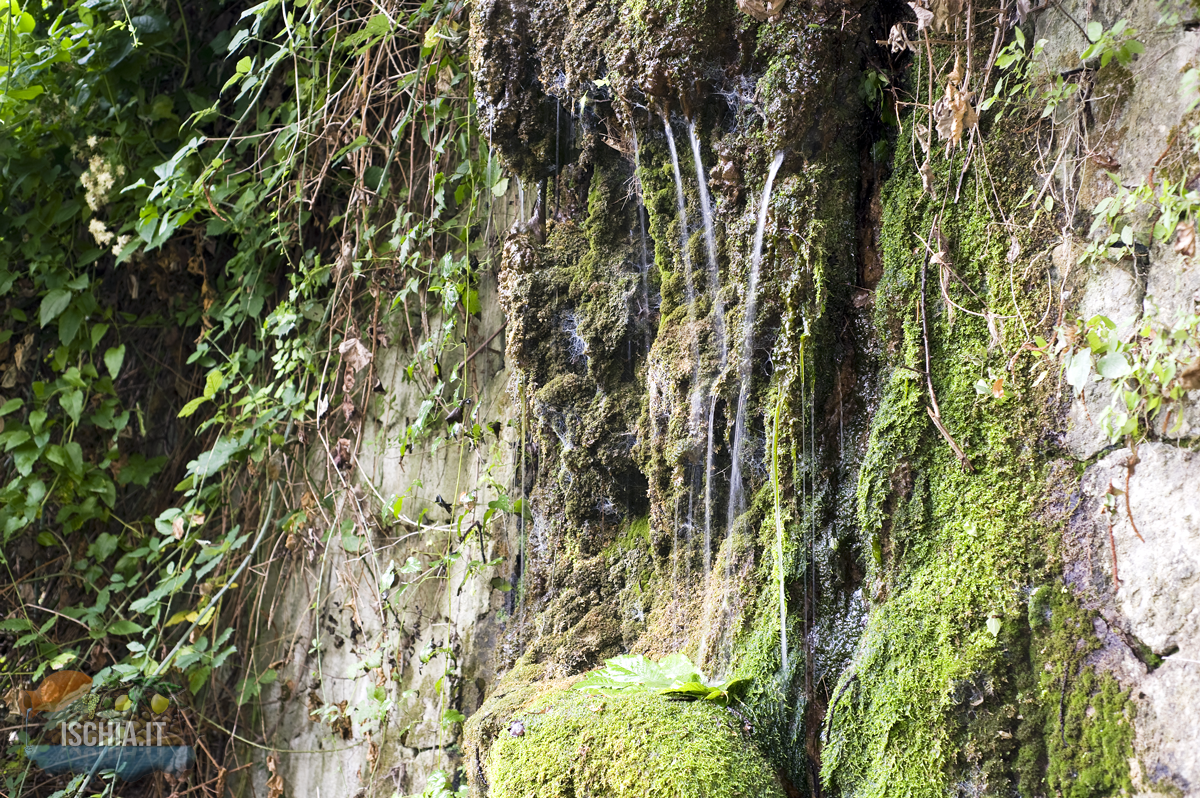The enveloping silence of the forest amplifies the chirping of birds. They fly up, as soon as they sense the human presence and cease for a moment to be the undisputed masters of the place.
Which perhaps took its old name from them, Abocaetus, from which the most usual Buceto derives. Common to both the mountain that rises near Epomeo and overlooks the ancient craters, now surrounded by greenery,
Rotaro is the source that flows from its lively side, to the East side, there where go to drink flocks of birds. Pure and fresh water, which descends from the top of the hill through the clayey rocks.
The Greek colonists, and then the Romans ones, had also appreciated it, the large pool to be used, protected by the thick chestnut grove, close to their villages in the Toccaneto area.
Precious water, whose fame in the following centuries had spread far beyond the green heart of the Green Island. To satisfy the needs of the village had always been a source on the beach that bordered the bay of Sant’ Anna, at the foot of the Tower of the noble Guevara in front of the islet of the castle, then the city of Ischia.
That source quoted by Boccaccio, is the place where Restituta Bulgaro and Giovanni da Procida met, the two lovers protagonists of the sixth novel of the fifth day of his “Decamerone”. The characteristic bradyseism of that side of the island, which had already swallowed the Angevin port, had slowly made sink in the sea with the source and now the inhabitants of the Castle and the village no longer had to supply themselves.
The solution was identified in the distant source of Buceto, the only vein of water sufficient for the needs of the population.
Pressed by the people, the University of Ischia began to ask with ever-greater insistence the intervention of the viceroy Cardinal of Granvela, until he did not send on the island as governor a noble Spanish knight, Don Orazio Tuttavilla, just to realize the impressive public work. In order to finance it, the viceroy conceded that all income from duties on wine should be devolved, instead of allocating them as always to the Royal Court.
Works began in 1590. The aqueduct way was long and difficult and Tuttavilla was able to make about half of it, piercing a mountain and bringing water downstream. The technical and financial difficulties that arose during construction did not allow going further and the death of Tuttavilla definitively blocked the project.
It took more than eighty years to resume the works.
This time, Bishop Girolamo Rocca, who at that time hosted young Giovan Battista Vico as preceptor of his nephews, took on the requests of the Ischisans. The bishop allocated to the enterprise all the income of the church of Ischia and his personal ones, but they were not enough, so much so the University was forced to impose new taxes on flour, on cereals and still on wine. For the first time the bishop obliged the clergy to contribute.
For the construction, the volcanic stone of the eruption of 1301 was used, when the lava had followed almost the same path. The style was that of the Roman aqueducts, which often leads today to attribute erroneously to a much older era the seventeenth-century monument, commonly known as the “Pilastri”, (Pillars), which historically marks the boundary between the territory of Ischia and that one of Barano, where the water of Buceto originates…
Finally, thanks to the efforts of Monsignor Rocca, the work was successful. In the village, next to the Church of the Holy Spirit, a fountain was installed adorned with two marble griffins and below the road was created a cistern where regularly flowed the water of Buceto, together with rainwater collected on the roof of the church.
The enterprise was celebrated again in the village seventy years later, when in 1759 on the new facade of the Palazzo dell’Orologio, then the Town Hall, a large travertine basin was inaugurated with the water of Buceto and a marble plaque was affixed.
Still today it is in plain sight, in which was commemorated the accomplished enterprise to get the water from the source of Buceto, distant four thousand steps from the village under the Castle.
Once the village and the city of Ischia were quenched, a century later it was once again in Buceto to give water to the Royal Palace and the new inhabited area of Villa de’ Bagni, which was developing near the lake, where they worked hard at the opening of the new port.
It was 1853 and King Ferdinando II financed another branch of the aqueduct to feed, with his Ischian residence, also a public fountain outside the palace, in today’s Piazza Antica Reggia, below which another was created large cistern for the drinking water reserve for the benefit of the population.
Of the thirteen public fountains to which the Ischitans had drawn the water of Buceto for three centuries, only one remained active in Fiaiano, in front of a magnificent view of the Gulf that can be admired along the road of Rotaro.
A naturalistic route to enjoy in every season of the year, accompanied by tall chestnut trees and evergreen holm oaks, under which a luxuriant maquis of heather and strawberry trees grows.
Marked by a red lizard, the Path of the Great Crater is one of the most fascinating itineraries to discover the pristine interior of the island. From Fiaiano, passing through Marecoppo and Monte Trippodi, you reach Monte Buceto, in the thick chestnut forest where the most precious water is collected, on the island from the largest thermal-mineral basin in Europe. Fresh water, rare water. Water of life.
For centuries, before it could come from the sea.
di Isabella Marino


